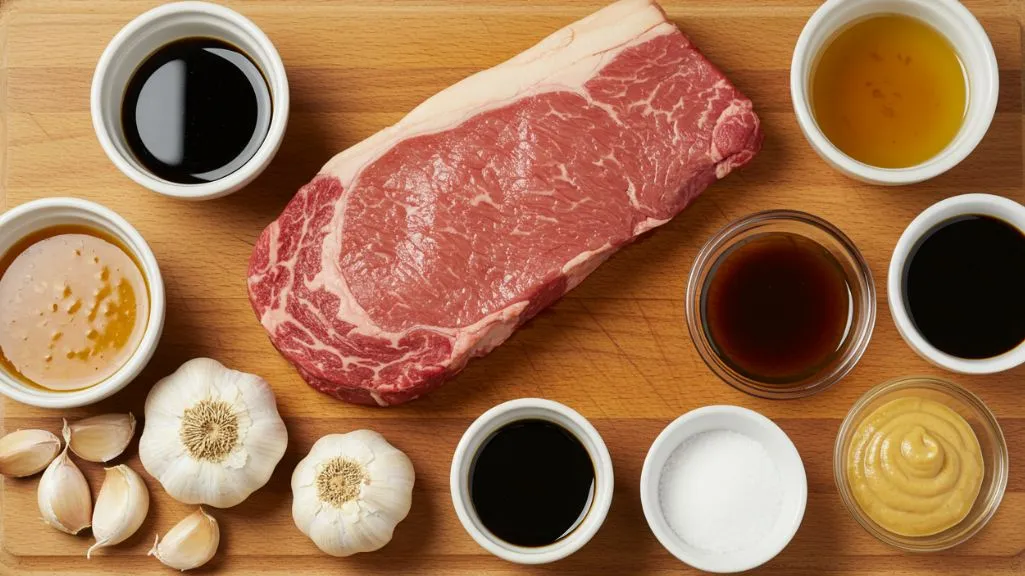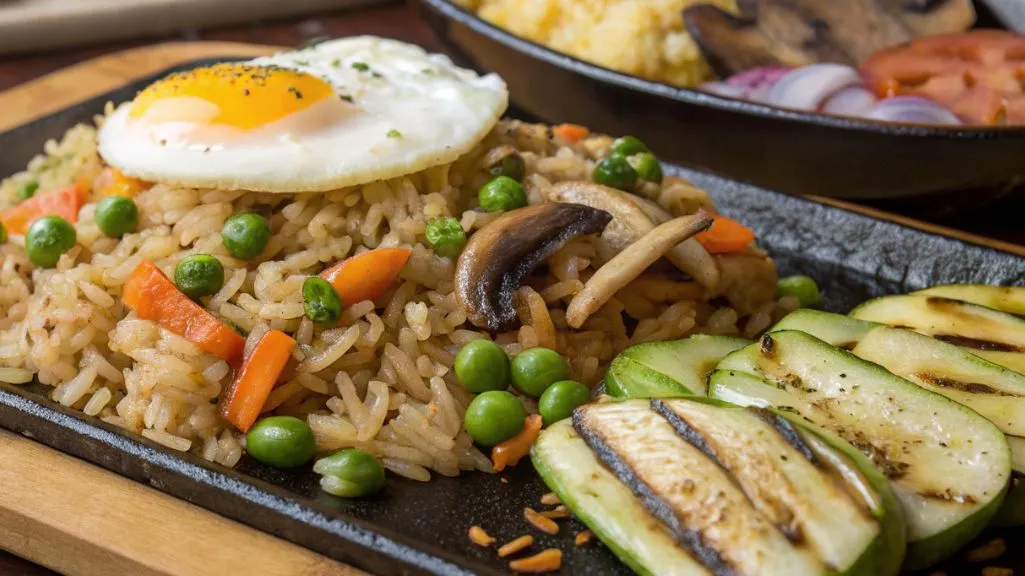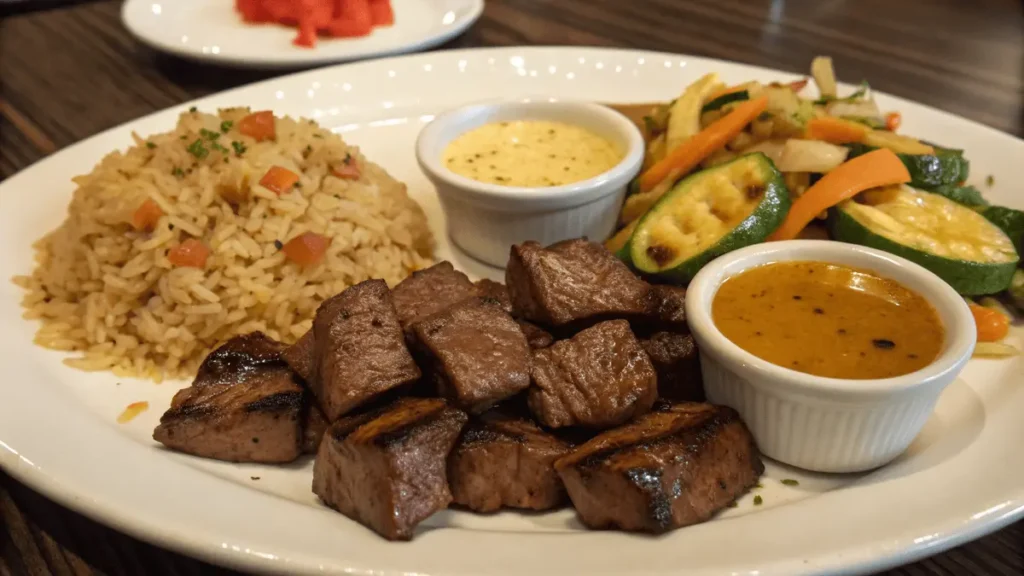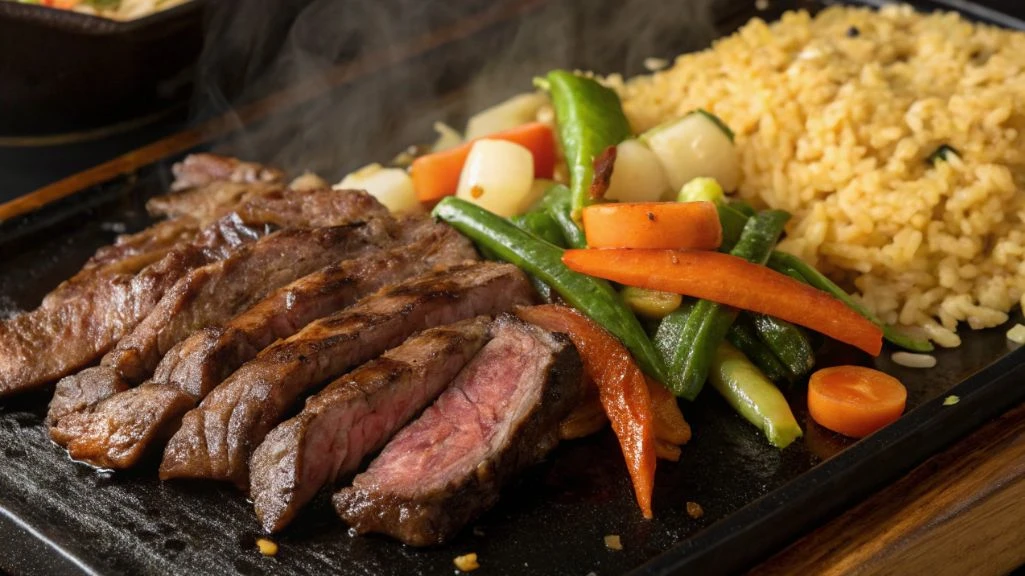How to Make the Best Hibachi Steak Recipe at Home
Craving that sizzling, juicy steak from your favorite Japanese steakhouse? You’re not alone. With the mouthwatering aroma of seared beef, buttery vegetables, and fried rice wafting through the air, hibachi steak has become a beloved go-to comfort meal for many. But guess what? You don’t need a chef’s hat or a giant grill to make it.
In this step-by-step guide, we’ll walk you through how to create the best hibachi steak recipe from the comfort of your own kitchen. From choosing the right cut of beef and nailing that signature sauce to mastering the side dishes like fried rice and veggies — we’ve got it all covered. Whether you’re replicating the classic Benihana experience or adding your own twist, this guide is your one-stop destination for all things hibachi.
Let’s get that skillet hot and your taste buds ready!
Table of Contents
Introduction to Hibachi Steak
What is Hibachi Steak?
Hibachi steak is a classic Japanese-American dish that brings together high-heat seared steak, bold sauces, and tender veggies in one show-stopping meal. Traditionally cooked on a flat-top grill called a teppanyaki, it combines simple ingredients with theatrical flair. The term hibachi actually refers to a small, charcoal-heated grill, but in the U.S., it’s often synonymous with the steakhouse experience — think sizzling food, flying spatulas, and chefs with serious skills.
But here’s the secret: the magic isn’t in the restaurant — it’s in the technique and flavor. By using the right ingredients and cooking methods, you can easily recreate that iconic flavor at home — minus the chef’s tricks (unless you’re feeling fancy!).
Why Make Hibachi Steak at Home?
Why spend big bucks dining out when you can bring that same restaurant-quality taste to your kitchen? Making your own hibachi steak recipe at home means full control over ingredients, spice levels, and portion sizes. Plus, it’s quick! In less than 30 minutes, you can whip up a hearty, protein-packed meal that’s both healthy and comforting.
Even better, homemade hibachi is perfect for meal prep, date night, or impressing guests. It’s customizable too — toss in your favorite veggies, tweak the sauces, or swap steak cuts to suit your mood. Whether you’re after a weeknight winner or a weekend feast, this is one recipe that delivers every time.
Key Ingredients for the Best Hibachi Steak Recipe
Choosing the Right Cut of Steak (Ribeye, Sirloin, Filet Mignon)

When it comes to nailing a hibachi steak recipe, the cut of beef is a big deal. The most popular choices? Ribeye, sirloin, and filet mignon — and for good reason.
Ribeye is a fan favorite thanks to its marbling. That fat melts beautifully when seared, adding richness and a melt-in-your-mouth texture. If you’re after something a bit leaner, sirloin is a solid pick. It cooks quickly, stays tender, and won’t break the bank. Now, if you’re feeling a little fancy, filet mignon offers buttery tenderness that elevates your hibachi to steakhouse status.
No matter the cut, aim for about 1-inch thick steaks. This helps you get that perfect sear without overcooking the inside. And remember, room-temp steaks cook more evenly — so let them sit out for 15–20 minutes before cooking.
Essential Sauces and Seasonings (Soy Sauce, Garlic, Sesame Oil, Coconut Aminos)
Here’s where the real flavor kicks in. A great hibachi steak recipe thrives on its bold, umami-packed seasoning.
Start with soy sauce or coconut aminos for a salty base. Add minced garlic, a splash of sesame oil, and a hint of sugar or honey for balance. Want more kick? Toss in a dash of ginger or a sprinkle of black pepper. These flavors come together in minutes and turn plain steak into a savory, sizzling dream.
Don’t forget the sauces! Yum yum sauce and mustard sauce are iconic — creamy, tangy, and made to dip.
Preparing Your Kitchen for Hibachi Cooking
Equipment Needed (Flat Top Grill, Cast Iron Skillet, or Wok)
You don’t need a restaurant setup to cook a killer hibachi steak recipe. In fact, you probably have everything you need already!
While a flat-top grill is traditional, a cast iron skillet or large wok will do just fine. Why? Because they hold heat well and let you sear meat fast — which is exactly what hibachi cooking demands. If you have a griddle pan, that works too. Just make sure it gets super hot before the steak hits it.
Tongs, a sharp knife, and a cutting board round out your gear. And if you really want to go full hibachi chef, grab a metal spatula for flipping and scraping.
Prepping Your Ingredients Ahead of Time (Mise en Place for Hibachi)
One of the biggest secrets to any hibachi steak recipe? Prep everything first. Seriously — hibachi cooking moves fast. Once your pan is hot, there’s no time to chop onions or hunt for sauces.
Dice your veggies, cut your steak into bite-sized cubes (if desired), and whisk up your sauces. Line everything up near the stove so it’s all within reach. That way, you’ll be flipping, sautéing, and serving like a pro in no time.
Step-by-Step Hibachi Steak Recipe
Marinate the Steak for Maximum Flavor
If you’re aiming to master a hibachi steak recipe, don’t skip the marinade. It’s the secret sauce — literally.
In a bowl, mix soy sauce, sesame oil, minced garlic, and a splash of rice vinegar. Add a touch of sugar or honey for sweetness. Then, toss your cubed or whole steak cuts into this liquid gold and let them soak for 30 minutes to 2 hours. The longer, the better — but even 20 minutes will boost flavor.
This blend seeps into the meat, making every bite juicy, rich, and savory. Trust me, it’s worth the wait.
Cooking the Steak to Perfection on High Heat
Now the fun part — it’s time to sizzle. Fire up a cast iron skillet or flat-top griddle over high heat. Add a dab of butter or oil, and once it’s shimmering, lay those marinated steaks down.
Sear each side for about 2–3 minutes if cubed, or 4–5 minutes if whole. You want a nice crust while keeping the inside medium rare or medium. Hibachi steak is all about that balance: a charred outside with tender, juicy meat inside.
Don’t overcrowd the pan — work in batches if needed. And resist flipping too early!
Making the Classic Hibachi Steak Sauce
While your steak rests, let’s whip up that dreamy sauce. Combine:
- 1/4 cup mayo
- 1 tbsp ketchup
- 1 tsp rice vinegar
- 1/2 tsp garlic powder
- 1 tsp sugar
- A pinch of paprika
That’s your yum yum sauce. It’s tangy, creamy, and perfect for dipping. You can also stir together soy sauce, butter, and a touch of garlic for a quick steak glaze.
Once everything’s done, drizzle sauce on top or serve it on the side for dipping.
Hibachi Sides: Fried Rice, Vegetables, and Sauces

How to Make Japanese Fried Rice at Home
No hibachi steak recipe is complete without fried rice. It’s the ultimate sidekick — savory, buttery, and loaded with flavor.
Start with day-old rice (it fries better!). Heat sesame oil or butter in a skillet, toss in diced onions, carrots, and peas. Stir until soft, then push them to one side. Crack in an egg, scramble it, and mix it with the veggies. Add the rice, splash in soy sauce, and stir-fry everything until hot.
Want extra protein? Add chopped chicken, shrimp, or tofu. It’s fast, easy, and totally addicting.
Sautéing Hibachi Vegetables (Zucchini, Mushrooms, Onion, Carrots)
Veggies at a hibachi grill are always a hit. At home, you can recreate them in one pan.
Cut zucchini, onions, carrots, and mushrooms into chunks. Sauté them over medium-high heat in a mix of butter and soy sauce. Add a pinch of garlic powder or ginger for more punch.
Cook until they’re golden on the outside but still have a bite. For added flair, sprinkle sesame seeds over top. This medley pairs beautifully with steak and rice, making it a well-rounded meal.
For more delicious beef ideas, check out our Garlic Butter Steak and Potatoes Recipe for another steakhouse-style favorite you can make at home.
Benihana-Style Copycat Secrets

Replicating the Benihana Experience at Home
There’s something magical about eating at Benihana — the sizzling grill, the chef’s tricks, the rich aroma. But good news: you can recreate much of that charm right in your own kitchen with the right hibachi steak recipe.
Start by embracing the Benihana mindset. Keep it simple but precise. Use fresh ingredients, high heat, and quick cook times. Presentation matters too — slice your steak evenly, serve everything hot, and pair with dipping sauces like yum yum or mustard sauce.
To go the extra mile, dim the lights, crank up some ambient music, and serve your meal with a flourish. That small bit of showmanship goes a long way.
Flavor Profiles and Cooking Techniques Inspired by Japanese Steakhouses
Benihana’s flavor hits a balance of umami, sweetness, and just a touch of spice. To mimic this, don’t be shy with soy sauce, garlic, and butter. A splash of mirin or sake adds that extra depth.
Quick searing locks in the juices, so don’t overcook the steak. And always let it rest for a couple of minutes before serving — that’s a chef’s trick worth remembering.
Overall, a true Benihana-style hibachi steak recipe is all about keeping it hot, fast, and flavorful.
Common Mistakes to Avoid When Making Hibachi Steak
Overcooking the Steak
This is a big one — and easy to do. Because hibachi-style cooking uses high heat, it’s easy to go from medium-rare to well-done in seconds. Always watch your steak closely. Use a thermometer if you’re unsure: 130–135°F is perfect for medium-rare.
Cutting the steak too soon is another common slip-up. Letting it rest for a few minutes before slicing helps keep it juicy and tender.
Using the Wrong Pan or Temperature
A nonstick pan might seem easier, but it won’t give you that restaurant-style sear. Instead, grab a cast iron skillet or griddle. They hold heat better and create that crisp crust you want in any great hibachi steak recipe.
Also, don’t start with a cold pan. You need that sizzling-hot surface to lock in flavor fast. Preheat it well — your steak will thank you.
Serving Suggestions and Meal Ideas
What to Serve with Hibachi Steak
Now that you’ve mastered the hibachi steak recipe, it’s time to plate it like a pro. Classic sides like fried rice and sautéed vegetables are must-haves — they balance the rich steak with savory textures and flavors. You can also serve a light soup or miso broth to start the meal.
Want something a bit different? Try pairing your steak with garlic noodles or even a crisp Asian slaw for a fresh contrast. A sprinkle of sesame seeds and chopped scallions adds color and crunch.
Creating a Full Hibachi-Style Dinner Experience
To really wow your guests (or yourself), go full hibachi. Serve the meal in courses — start with soup or salad, move to steak and veggies, and end with a simple dessert like green tea ice cream.
Don’t forget the sauces! Yum yum and ginger sauce tie the whole thing together and let everyone dip and drizzle to their heart’s content.
Storage and Reheating Tips
How to Store Leftover Hibachi Steak
Got leftovers? Great! Store any extra steak in an airtight container in the fridge. For up to three days, it will remain fresh. Keep the sauces and veggies in separate containers to avoid sogginess.
Best Methods for Reheating Without Drying Out
Reheating your hibachi steak recipe the right way makes all the difference. Skip the microwave — it dries the meat out. Instead, toss it in a hot skillet for a minute or two, or reheat it in the oven at 300°F, covered with foil, until warm. Add a splash of soy sauce or water to bring back moisture.
FAQs – People Also Ask
Q: What cut of steak is used in hibachi?
In most hibachi steak recipes, chefs use cuts that are tender and flavorful. The most common choices are sirloin, ribeye, and filet mignon.
Ribeye is rich and juicy due to its marbling, making it perfect for high-heat searing.
Sirloin is leaner, more budget-friendly, and still very tender.
Filet mignon offers a buttery texture and is often considered the premium pick.
All these cuts work wonderfully on a hibachi grill or skillet because they cook quickly and absorb flavors well.
Q: What seasoning do they use for hibachi?
Seasoning in hibachi is all about bold, simple flavors. A traditional hibachi steak recipe uses:
– Soy sauce
– Garlic (minced or powder)
– Sesame oil
– Salt and pepper
– Optional: ginger, butter, and a hint of sugar or mirin for sweetness
These create the umami-packed, savory taste that makes hibachi dishes so irresistible.
Q: What to marinate steak in for hibachi?
For a delicious hibachi steak marinade, you’ll want a balance of savory, sweet, and umami flavors. A simple and effective mix includes:
– Soy sauce or coconut aminos (as the base)
– Minced garlic
– Sesame oil
– Rice vinegar or mirin
A touch of honey or sugar
Let the steak soak in this mixture for at least 30 minutes — or up to a few hours — for deeper flavor.
Q: What kind of sauce is used in hibachi cooking?
Hibachi cooking features a few iconic sauces, typically served alongside the main dish. The most popular are:
– Yum Yum Sauce – a creamy, tangy, and slightly sweet mayo-based sauce
– Ginger Sauce – thinner and packed with sharp, fresh ginger flavor
– Garlic butter sauce – melted butter mixed with garlic and soy, often used during cooking
These sauces bring the hibachi steak recipe to life and are perfect for dipping steak, veggies, or rice.
Conclusion
Bringing the flavors of your favorite Japanese steakhouse into your own kitchen is easier than you might think. With the right ingredients, a hot skillet, and a bit of prep, you can whip up a restaurant-quality hibachi steak recipe that’s juicy, flavorful, and totally unforgettable. From sizzling steak and buttery veggies to fried rice and signature sauces, each element comes together to create a meal that’s both comforting and exciting. Whether you’re cooking for family, entertaining guests, or just treating yourself, this hibachi-style dinner delivers big flavor with minimal fuss. So go ahead fire up that pan and let the sizzle begin!

